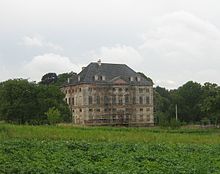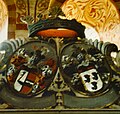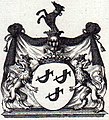Vieregg (noble family)
The gentlemen, barons and counts Vieregg , also Vieregge , Viereggen or Viereck belong to the Mecklenburg prehistoric nobility and were also able to gain some reputation in Bavaria , Prussia and Denmark . Branches of the family persist to this day.
history
Mecklenburg
The Vieregge family first appears with the brothers Diedrich and Grubo Vereghe , who were mentioned in documents in 1346, 1347 and 1349. The continuous lineage of the family begins with the above Grubo Vereghe , heir to Blengow , squire and chamberlain to Duke Albrecht I. A knight Otto was heir to Wokrent in 1348 . Other family estates from Mecklenburg were Rossewitz and Weitendorf . Otto Vieregge sold his half in 1375 in the villages of Moisling , Niendorf and Reecke to Hermann von Osenbrügge . In 1499 the family sold the village of Glasewitz to the dukes of Mecklenburg . In the diocese of Schwerin the Vieregg held the office of court marshal . In 1523 the Vieregg were co-seals of the Union of Estates . From 1498 to 1508 Sophie von Vieregge was the prioress of the Dobbertin monastery . Elise von Vieregge (1866–1951), married to Wilhelm von Amsberg (1856–1929), was the paternal grandmother of the Dutch Prince Consort Claus von Amsberg and thus great-grandmother of today's King Willem-Alexander .
In the registered book of the Dobbertin monastery from 1696 there are 14 daughters of the von Vieregg (e) family from 1739 to 1876 from Kobrow, Steinhausen, Wattmannshagen and Weitendorf for inclusion in the noble women's monastery there .
Bavaria

In 1552 Paul Vieregg did military service for Duke Albrecht of Bavaria . He married a Schellenberg in 1556 and died as governor of Höchstadt . From 1597 to 1833 Gerzen Castle was owned by the Bavarian line. In 1615 Dietrich Vieregg , heir to Görtzen ( Gerzen ), received the ducal-Bavarian noblemen's freedom. His son, Wolf Heinrich Viereckh , the Bavarian treasurer and carving master at the Bavarian and Cologne court, received permission to write from Viereckh on July 28, 1663 . His sons, the heir to Görtzen Ferdinand Joseph , the prince-bishop Freising court chamber councilor Maximilian Joseph and Georg Florian Erasmus , were raised to the status of imperial barons by Emperor Leopold I on December 10, 1692 . During the Bavarian vicariate , on March 1, 1790, he was raised to the rank of imperial count for the curb-Bavarian Privy Councilor, treasurer and head stable master Matthäus Carl Anton von Vieregg (1719-1802), son of the above Baron Ferdinand Joseph zu Görtzen. Count Franz Joseph von Vieregg , son of the above mentioned Matthäus , heir to Tutzing and Bavarian major general , enrolled in the Bavarian count class of knighthood on March 18, 1809. The enrollment in the baron class of knighthood took place on February 3, 1813.
On April 14, 1846, Count Matthäus von Vieregg (1719–1802) founded the Bavarian Family Fideikommiss for the Upper Bavarian and Lower Bavarian family goods.
Graf-Vieregg-Straße in Tutzing is named after the family. Epitaphs of the Vieregg can be found in St. Peter and Paul in Feldafing and in the former parish church of the same name in Tutzing.
Prussia
In 1590 the family settled on Gut Vorwerk near Lassan in Western Pomerania . Matthias Viereggen had acquired the estate from his son-in-law Joachim Zitzewitz with ducal permission as a pledge. Already in 1603, the castle justice not until 1613, the lien was confirmed to the son of Matthias , Jakob Viergge . The latter sold his share in Relzow to Rudolph von Elwern in 1639 , after which the family in Pomerania did not appear any more until further notice.
Adam Otto von Viereck (1684–1758), heir to Weitendorf and Wattmannshagen , electoral Brandenburg Privy Council and Higher War Commissioner received the Prussian indigenous community in Kleve in August 1692 .
Henriette Dorothea Ursula Katharina von Viereck († 1854), daughter of the royal Prussian headmaster Georg Ulrich von Viereck , was mistress of Lossow and first lady-in-waiting and registrar of Queen Luise , she was raised to the Prussian count status on March 30, 1834. In 1836 she had Schinkel build the Sillginnen manor in East Prussia .
Denmark
The father of the same name, Adam Otto von Viereck (1634–1717), was the Prussian ambassador in Copenhagen from 1698 to 1706 . His daughter Elisabeth Helene von Vieregg (1679–1704), initially lady-in-waiting to the sister of the Crown Prince, Princess Sophie Hedwig (1677–1735), became Frederick IV's mistress in 1699 . On September 6, 1703 she was raised to the Danish count status. However, she died in childbed with a boy, Frederik Gyldenløve (1704-1705), after which the king entered into another morganatic relationship.
On March 28, 1776, the Danish nobility naturalization for Frederik Ludvig von Viereck from the Kobrow line took place . He was a royal Danish chamberlain and later bailiff and governor on Fehmarn . He founded the Danish line of sex.
The Danish governor of Norway , Claus Henrik Vieregg , the Danish major general Julius Johann von Vieregg (1689–1756) and the Danish diplomat Cuno Hans von Vieregg (1728–1795) also gained greater prominence in the Danish service .
possession

- in Mecklenburg: Altenhagen, Groß Belitz , Benitz , Blengow, Bresen, Bristow , Bubzien, Bussewitz , Dettmannsdorf , Dudinghausen, Galtzien, Glasewitz, Gramtzow, Gremmelin , Güstow , Kobrow, Groß and Klein Kranckow, Kronskamp, Groß and Klein Lantow , Levkendorf, Mierendorf , Moisling, Moysal, Niendorf, Püchow, Raden, Reecke, Roggow, Rossewitz , Spoitgendorf (until 1753), Steinhagen, Steinhausen, Subsin / Subzien, Vinstorf, Wattmannshagen , Weitendorf, Wichmannsdorf, Wentorff, Woland, Wokrent , Wustrow, Zabkendorf and Ziersdorf
- in Bavaria: Bertensdorf, Furtharn, Garatshausen , Gerzen , Götzdorf, Hilpoltstein , Lay , Pähl , Rösselsberg, Sattelthambach, Starnberg , Schöllnach , Seiboldsdorf, Thürnthenning , Tutzing, Weinsfeld and Wieling
- in Denmark: Antvorskov
- in Prussia : Kampenbruch, Karschau, (Kuglacken), (Megussen), Postehnen and Sillginnen
- in Pomerania : Borrentin , Plüggentin , Jasedow, Papendorf, Pulow , Relzow, Vorwerk bei Lassan and Warnekow
- in Brandenburg: Birkholz , Carow, Cossar and Lossow with Buschmühle
- in Hanover : Schwanewede
coat of arms
The tribe coat of arms shows 3 (2, 1) in silver, each obliquely left, with a black hook covered with overturned black hunting horns or fire or well hooks with red inside . On the crowned helmet with black and silver covers a growing black greyhound with a gold collar.
Coat of arms on the patron s box of the church of Hohen Sprenz
Known family members

- Adam Otto von Viereck (1634–1717), ducal mecklenburg-güstrowscher chamber president and Prussian envoy in Copenhagen
- Claus Henrik von Vieregg (1655–1713), governor of Norway from 1712 to 1713
- Countess Elisabeth Helene von Vieregg (1679–1704), mistress and secret wife of Frederick IV of Denmark
- Adam Otto von Viereck (1684–1758), Prussian Minister of State and Privy Budget Councilor, Knight of the Black Eagle Order
- Carl Henrik von Vieregg (1686–1747), Danish state councilor, privy councilor and bailiff in Hadersleben , provost in Hamburg
- Julius Johann von Vieregg (1689–1756), Danish major general
- Matthäus Carl Anton von Vieregg (1719–1802), curb-Bavarian Privy Councilor, chamberlain and chief stableman, conference minister for foreign affairs, as well as governor and forester of Höchstadt, 1769 Grand Cross Lord of the Order of Saint Hubert and Commander of the Order of St. George
- Friedrich Ludwig Matthias von Vieregge auf Subzin, Rittmeister, 1761–1768 provisional in the Dobbertin monastery
- Adam Otto von Vieregge auf Steinhausen, chamberlain, 1799–1820 provisional in the Dobbertin monastery
- Christian Friedrich von Viereck (1725–1777), Prussian major general
- Cuno Hans von Vieregg (1728–1795), Danish diplomat
- Ernst Vollrad von Vieregge (1744–1816), Prussian major general
- Count Friedrich von Vieregg (1752–1843), Major General of the Palatinate, Grand Cross of the Order of Malta, Commander of the Coming Landsberg and Real Privy Councilor, in 1802 he was Hofmarkherr zu Tutzing
- Baron Anton von Vieregg (1755–1830), General of the Bavarian Army and holder of the Commander's Cross of the Military Max Joseph Order .
- Henriette Countess von Viereck (1766–1854), first lady-in-waiting of Queen Luise , had the manor house Sillginnen / East Prussia built by Schinkel in 1836
- Count Karl Matthäus von Vieregg (1798–1864), Lieutenant of the 1st Hussar Regiment, Major General of the Landwehr, Colonel à la suite and Knight of Malta
- Count Friedrich Max von Vieregg (1833–1866), KuK treasurer and hussar officer
- Gustav von Viereck (1845–1906), manor owner and member of the German Reichstag
- Elise von Vieregge (1866–1951), great-grandmother of the King of the Netherlands Willem-Alexander and grandmother of the Prince Consort Claus von Amsberg
- Hans von Viereck (1872–1943), German lieutenant general
- Henning von Vieregge (born August 27, 1872 in Steinhausen near Neuburg, † May 3, 1945 ibid), officer
- Henning von Vieregge (* 1946), doing his doctorate with Karl Dietrich Bracher , 1996 to 2008 managing director of the general association of communication agencies GWA , 2011 to 2012 chairman of the board of trustees of the cooperation foundation , 2012 until its dissolution in 2015 chairman of the community spirit eV, Bonn
- Konrad von Viereck (* 1947), former managing director of McCann Erickson Germany and Eastern Europe, managing director of the foundation of the Hamburg University of Applied Sciences
literature
- Julius Theodor Bagmihl : Pommersches Wappenbuch . Stettin 1855, Volume 5, pp. 117-118 , Volume 55
- Genealogisches Handbuch des Adels , Adelslexikon Volume XV, Volume 134 of the complete series, S, 241–243, CA Starke Verlag , Limburg (Lahn) 2004, ISSN 0435-2408
- Otto Titan von Hefner , George Adalbert von Mülverstedt and Adolf Matthias Hildebrandt : J. Siebmacher's Great General Wappenbuch. New sieve maker . Nuremberg 1854–1858.
- Oswald Kiehn: von Viereck, von Vieregge In: Deutsches Familienarchiv 71, 1979, pp. 184-187
- Ernst Heinrich Kneschke : German count houses of the present in heraldic, historical and genealogical relation. Leipzig 1854, Volume 2, p. 601
- Ernst Heinrich Kneschke: New general German nobility lexicon . Leipzig 1870, Volume 9, pp. 387-388
- Leopold von Ledebur : Nobility Lexicon of the Prussian Monarchy . Berlin 1858, Volume 3, pp. 56-57
- Gustav von Lehsten: The nobility of Mecklenburg since the constitutional hereditary comparisons (1755). Rostock 1864, p. 275
- Wolf Lüdeke von Weltzien: The knight seat Rossewitz. u. The von Vieregge (on Gremmelin). In: Families from Mecklenburg a. Western Pomerania. Volume 4, 1995, pp. 99, 105 and 222-235
- Henning von Vieregge, Steinhausen. In: Mario Niemann: Rural life in Mecklenburg in the first half of the 20th century. Rostock 2004, pp. 771-782
- Leopold von Zedlitz-Neukirch : New Prussian Adelslexicon . Volume 4. Leipzig 1837, p. 296
- Konrad von Viereck: Without reason. A life after 1945. Thomas Helms Verlag , Schwerin 2016. ISBN 978-3-944033-28-0 .
- Sebastian Joost: Paths through the centuries. The noble family Vieregge, Vieregg, Viereck. Kohlhammer, Stuttgart 2020. ISBN 978-3-17-036760-9 .
Web links
- Literature about families (from) Viereck in the state bibliography MV
- The von Vieregge family in the Wildenfels castle archive
- Coat of arms of the "Vieregge (n)" in Siebmacher's Wappenbuch from 1701, Volume 5, Plate 149 and Plate 169
- the V. Square on the Mecklenburg-Western Pomerania landscape
Individual evidence
- ↑ See Mecklenburgisches Urkundenbuch , Volume X, No. 6709, 6751, 6994.
- ↑ Danmarks Nobility Aarbog. Volume 52, 1935, Afsnit 2, pp. 115-132.



